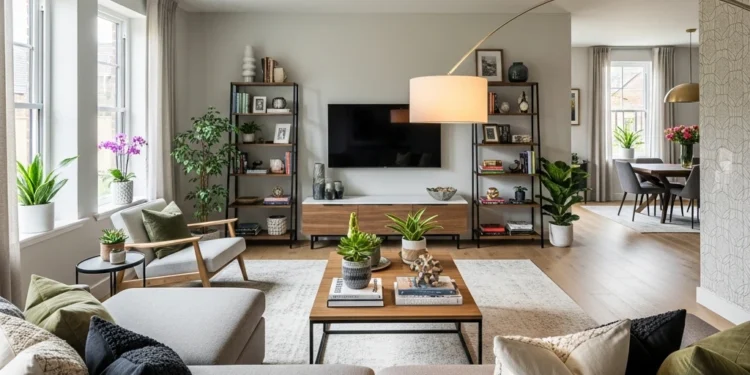People designing small homes incorporate several techniques to make the space appear bigger. Some install large mirrors; others choose minimalist or multifunctional furniture. But one secret adds an illusion of more space—and it’s just under your feet. It’s the floor tiles.
The right floor tile patterns can change the entire look of a home’s interior. If you’re feeling cramped at home, it might be time for an upgrade! This piece will discuss the ideal patterns and tile types that make your tiny place appear more spacious.
Focal Point Tiles
An easy way to create more space in a small room is to design a focal point on your floor with tiles. This method draws your eyes to a specific spot, making a smaller space feel more intentional.
Put tiles in a bold color or pattern in the center of the floor or underneath another focal point in the room. This spot can be a kitchen island or a pedestal sink. Meanwhile, the other surrounding tiles are simpler in design, color, and shape to make the focal point pop. Why not lay them out in a chevron pattern to lead the eyes toward the focal point on the floor?
Another technique is using borders, which involve different-shaped tiles or patterns. Consider using colored or patterned tiles as the border around the room’s perimeter while filling the leftover space with plainer tiles. If you wish, the floor can still have a focal point tile design or piece of furniture. Check out these tile floor border ideas for more examples you can try on your next home renovation project.
Smaller Patterns
Small floor tile patterns work best with small homes or rooms. For instance, powder rooms or pantries appear more proportional with dainty penny-round tiles. Larger tiles with massive patterns give the opposite effect, looking out of scale.
Herringbone and basketweave tiles are two other fantastic options to consider. These patterns trick the eyes into thinking that a room has more detail and dimension. Besides being small-scale patterns, they’re stylish and keep spaces cohesive and uncluttered.
Hexagon Tiles
Hexagon tiles are also great picks for small spaces. They have a honeycomb shape that’s trendy yet timeless, ideal for any home with tighter rooms. Their geometry forms a continuous flooring pattern that creates depth to a floor’s appearance.
Smaller hexagonal tiles add texture and charm, while larger patterns give a seamless, modern effect. When choosing hex tiles, go bold with colors or stick to clean and classic white. Either way, this tile pattern type will give your small space more character and a sense of movement.
Lighter Colors
Don’t just focus on floor tile patterns and shapes—play around with colors, too! Color is a useful and powerful tool when dealing with limited square footage.
Use tiles in shades of cream, white, or soft grays. Not up for neutrals? Pastels are also a great choice. Lighter colors help make a room feel brighter and more open since they reflect more light. You’ll notice fewer shadows and a better ambiance when entering a room with these tile colors.
Consider using monochrome color schemes with subtle variations or discreet designs. When you have fewer colors to work with, you can incorporate one-tile or two-tile patterns easily. This patterning technique with lighter shade palettes creates visual continuity and emphasizes spaciousness.
Glass Tiles
Looking for something a little more elegant? Try using glass tiles. Like light-colored tiles, glass reflects light, allowing it to bounce around the room. Small spaces with glass tiles often appear more airy and illuminated.
Glass mosaic tiles, in particular, are excellent for small kitchens and bathrooms. These tiles add extra shimmer and style to the floor while giving the illusion of more space. You can also install them on walls, providing a unified, unbroken look.
Practice caution when you choose glass tiles. They can be slippery when wet and receive scratches more easily than other tile types. Furniture socks and soft-soled shoes can prevent untimely damage to your floor.
Rectangular Tiles
If you prefer something simpler yet effective in small rooms, rectangular tiles might be what you need. Subway or plank-style tiles work particularly well. When laid in a horizontal orientation, they elongate the width of a narrow space. On the other hand, a vertical placement creates the illusion of a higher ceiling. No matter the available space, these floor tile patterns are easy to achieve.
For a hint of sophistication, use a herringbone layout with rectangular tiles. This pattern introduces movement while still being visually grounding and space-enhancing.
Continuous Floor Patterns
If you want to amplify the space of a small room, keep the floor pattern as consistent as possible. You might have to use the same pattern and color from one room to the next to maintain the illusion. White is a foolproof color to use for this technique, and it’s also a reviving home design trend. For instance, if your kitchen has an all-white checkerboard pattern, use the same design for neighboring areas.
To prevent visual interruptions, avoid abrupt changes in tile color, size, or pattern. Even a thin border could break the whole look. Continuous floor tile patterns create flow, guide the eye, and unify several rooms into a cohesive design.
Conclusion
Your home’s limited space doesn’t have to feel cramped all the time. A thoughtful choice in floor tile patterns can make a huge difference in how space feels and functions.
Strategies like creating focal points, installing glass tiles, or using continuous layouts provide significant help. With visual harmony at play, you can turn the smallest rooms into more open ones.












